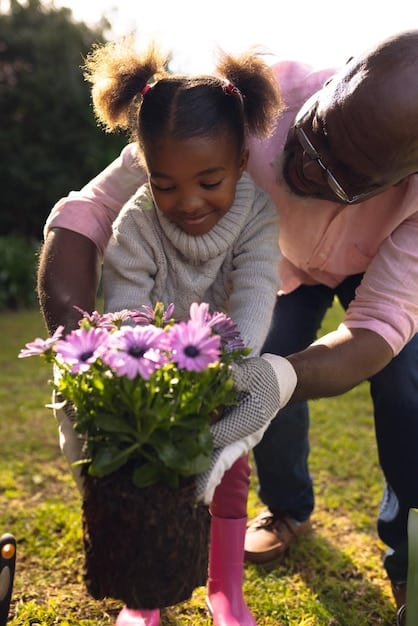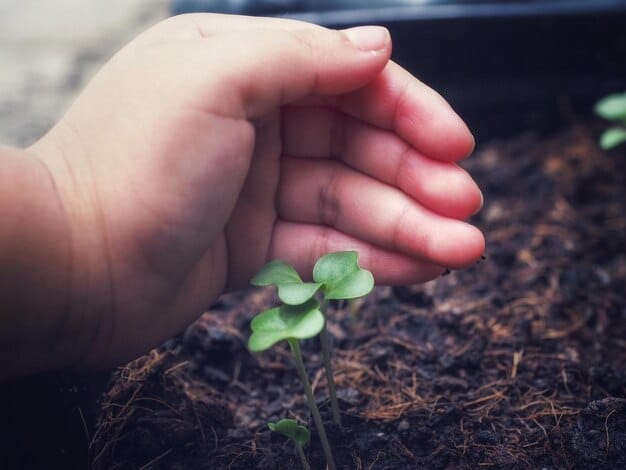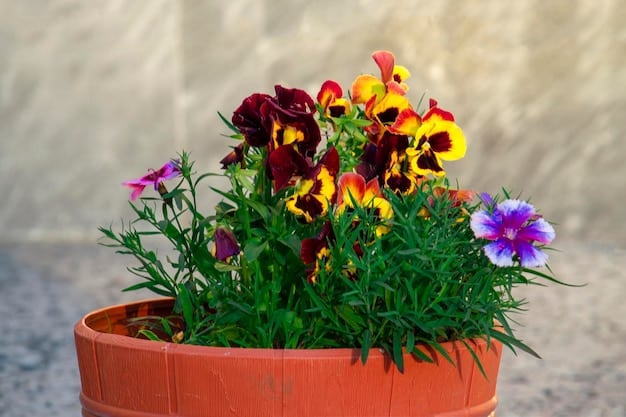Kindness in Bloom: Beautifying Communities Through Public Flower Plantings

Kindness in Bloom is about transforming public spaces by planting flowers, fostering community bonds and environmental beauty through collaborative gardening efforts, promoting positive social interactions and a shared sense of ownership.
Imagine a world where every public space bursts with vibrant colors and fragrant blooms. Kindness in Bloom: Plant Flowers in a Public Space and Beautify Your Community is more than just gardening; it’s an act of kindness that cultivates beauty and connection.
Spreading Joy: The Impact of Planting Flowers
Planting flowers in public spaces transcends mere aesthetics; it’s a powerful way to uplift spirits and enhance the overall quality of life. The simple act of cultivating beauty can have far-reaching positive effects on individuals and communities alike.
Enhancing Well-being through Floral Beauty
Flowers have a unique ability to evoke positive emotions and reduce stress. Studies have shown that exposure to nature, including flowers, can lower blood pressure and promote relaxation. By introducing floral displays in public areas, we create havens of tranquility amidst the hustle and bustle of daily life.
Creating a Welcoming Environment
A well-maintained and visually appealing environment can foster a sense of pride and belonging within a community. Flowers add color, texture, and vibrancy to spaces, making them more inviting and enjoyable for everyone. This simple act of beautification can encourage social interaction and strengthen community bonds.
- 🌸 Boosts Mood: Flowers release endorphins, natural mood lifters.
- 🌼 Reduces Stress: Green spaces lower cortisol levels, reducing stress.
- 🌻 Increases Social Interaction: Beautiful spaces encourage community gatherings.
- 🌷 Enhances Community Pride: Well-maintained areas foster a sense of belonging.
By transforming neglected or underutilized areas into vibrant floral displays, we can create a more welcoming and enjoyable environment for all. This simple act of kindness can have a profound impact on the well-being of individuals and the cohesiveness of communities.
Planning Your Kindness in Bloom Project
Before you grab your gardening gloves and head to the nearest park, careful planning is essential for a successful Kindness in Bloom project. Consider logistical aspects and community engagement to maximize positive impact.

Identifying Suitable Locations
Begin by identifying public spaces in your community that could benefit from a touch of floral beauty. Consider parks, community gardens, schools, libraries, or even overlooked traffic islands. Evaluate the sunlight exposure, soil conditions, and accessibility of each location to ensure the flowers will thrive.
Securing Permissions and Resources
Once you’ve identified a suitable location, it’s crucial to obtain the necessary permissions from local authorities or property owners. Contact your city council, parks department, or community association to discuss your project and secure their approval. Additionally, consider collaborating with local nurseries or garden centers to source plants, soil, and gardening tools at discounted rates.
- ✔️ Contact Local Authorities: Obtain necessary permits for planting.
- 🌱 Partner with Nurseries: Secure discounted plants and materials.
- 🤝 Engage Community Members: Recruit volunteers for the project.
- 💧 Plan for Watering: Ensure a sustainable water source.
With proper planning and community support, create a thriving and beautiful space.
Choosing the Right Flowers
Selecting the right flowers is crucial for a successful and visually stunning Kindness in Bloom project. Consider factors such as climate, maintenance, and aesthetic appeal to ensure your floral display thrives and captivates onlookers.
Considering Climate and Soil Conditions
Opt for flowers that are well-suited to your local climate and soil conditions. Native plants are often a great choice as they are adapted to the environment and require less maintenance. Research the specific needs of different flower varieties to ensure they will flourish in your chosen location. For example, drought-tolerant species like lavender or succulents may be ideal for arid climates.
Selecting Colors and Varieties
When selecting colors and varieties, consider the overall aesthetic you wish to achieve. A mix of colors can create a vibrant and eye-catching display, while a monochromatic scheme can evoke a sense of elegance and serenity. Choose flowers with varying heights and textures to add depth and dimension to your planting. Consider incorporating flowers that attract pollinators like bees and butterflies to enhance the ecological value of your project.

Select flowers that not only beautify but also thrive, requiring minimal effort and maintenance. Use flowers that add beauty to the community.
Getting the Community Involved
A Kindness in Bloom project thrives when it becomes a collaborative effort. Involving community members not only expands the reach of your project but also fosters a sense of ownership and pride.
Organizing Planting Events
Host planting events to engage community members in the beautification process. Publicize the event through local media, social media, and community bulletin boards. Provide gloves, gardening tools, and refreshments to make the event enjoyable and accessible for all. Consider incorporating educational elements, such as workshops on gardening techniques or the importance of pollinators, to enhance the learning experience.
Fostering a Sense of Ownership
Encourage community members to take ownership of the project by assigning roles and responsibilities. Create a volunteer schedule for watering, weeding, and general maintenance. Organize regular clean-up events to keep the area looking its best. Recognize and celebrate the contributions of volunteers through appreciation events or public acknowledgements.
Collaborate for a thriving, shared public space.
Maintaining Your Floral Display
Once your flowers are planted, ongoing maintenance is essential to keep them thriving and looking their best. Regular watering, weeding, and pruning will ensure your Kindness in Bloom project continues to bring joy to the community for months to come.
Watering and Weeding
Establish a regular watering schedule, taking into account the specific needs of your chosen flower varieties and the local climate. Water deeply and consistently, especially during dry spells. Regularly weed the area to prevent unwanted plants from competing with your flowers for nutrients and resources. Consider using mulch to suppress weeds and retain moisture in the soil.
Pruning and Deadheading
Pruning and deadheading are essential for promoting healthy growth and encouraging continuous blooming. Remove dead or faded flowers to prevent them from going to seed and redirect energy back into the plant. Prune back overgrown or leggy stems to maintain a compact and attractive shape. Research the specific pruning requirements of different flower varieties to ensure you’re using the correct techniques.
Consistent effort helps your floral display flourish, bringing sustained beauty and positive impact to your community.
Measuring the Impact and Celebrating Success
Once the project is underway, assess the positive changes you’ve facilitated in your area. Celebrate the community, kindness, and beauty.
Gathering Feedback from Community Members
Collecting feedback from community members can provide valuable insights into the impact of your Kindness in Bloom initiative. You can achieve this through informal conversations, surveys, or by hosting community meetings. Inquire about how the floral display has affected their perception of the space and how it has contributed to creating a more positive community environment. Their feedback will help you gauge the project’s impact and tailor further improvements.
Showcasing the Project’s Successes
Share the achievements of your Kindness in Bloom project with the wider community by utilizing various communication channels. Highlight the transformation of the space, the increase in community engagement, and how the project has inspired others. You could create a visual display, such as a photo gallery or a video, showcasing the project’s progress over time. Additionally, engage with media outlets such as newspapers and local news channels to share your initiative’s story, thereby inspiring others to undertake similar projects in their communities.
These milestones foster community pride, and encourage long-term sustainability.
| Key Point | Brief Description |
|---|---|
| 🌱 Project Planning | Identify suitable location and secure necessary permission. |
| 🌷 Flower Selection | Choose weather-appropriate, visually appealing flowers. |
| 🧑🤝🧑 Community Involvement | Engage more people to take ownership for a lasting impact. |
| 💧 Maintenance | Water, weed, and prune regularly to keep the garden healthy. |
Frequently Asked Questions
▼
Planting flowers enhances the environment, boosts community well-being, and beautifies areas for public enjoyment. It fosters community pride and contributes to a more positive atmosphere.
▼
Contact your local city council, parks department, or community association to discuss your plans. Secure formal approval before starting any planting to meet local regulations.
▼
Choose native plants and flowers suited to the local climate and soil. This reduces maintenance. Flowers with bright colors can create a visually attractive display for community members.
▼
Organize planting events and publicize them through local media and community boards. Provide tools and refreshments to encourage participation. Share tasks to instill a sense of shared ownership.
▼
Establish a watering schedule and organize weeding sessions. Prune to encourage growth, and engage the community in regular maintenance activities. Consider mulch to manage weeds and retain moisture.
Conclusion
Kindness in Bloom is a wonderful initiative to transform public spaces through the beauty of flowers. By engaging communities and promoting acts of kindness, these projects can transform spaces. The collaboration will lead to happier and more beautiful communities.





